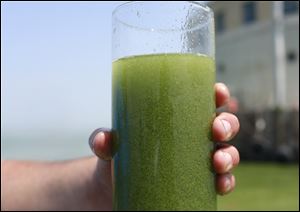
Planktothrix and microcystis: Not all algae are the same
3/19/2018
A sample glass of Lake Erie water is photographed near the City of Toledo water intake crib in 2014.
Not all algae are the same, says Bowling Green State University biology professor George Bullerjahn. Here are a few ways planktothrix and microcystis differ:
● Planktothrix arrives about two months earlier in Sandusky Bay. By mid to late May, planktothrix is forming in the bay; by Memorial Day it’s almost in full bloom. With a broader temperature range, planktothrix is fully capable of growing in the spring. Microcystis usually doesn’t form in the open water until late July, once the open water of Lake Erie warms up.
● Planktothrix grows fine in low light or darkness. Microcystis does not. But both are coming on stronger because of poor land use and climate change.
● Planktothrix doesn’t form large mats of scum on the water’s surface like microcystis does. Instead, planktothrix gets mixed well throughout the water columns of Sandusky Bay and area rivers. Mr. Bullerjahn said Sandusky Bay water is so “evenly stained green” by planktothrix that it can “lull people into a false sense of security that it's better than water with a surface scum on it.”
● Planktothrix relies more heavily on nitrogen, whereas microcystis relies more on phosphorus. There’s a “growing consensus” among scientists, however, that public policy officials need to pay more attention to both nutrients, Mr. Bullerjahn said. Current goals established by the states of Ohio and Michigan, as well as the province of Ontario, are focused on phosphorus. “Management of phosphorus alone won't work,” Mr. Bullerjahn said.
● Planktothrix seems to get all of the nitrogen it needs to thrive from a variety of sources, including what’s redistributed in the water by other types of algae. It is not as dependent on agricultural runoff from year to year. In 2016, when a lack of rainfall nearly kept Lake Erie’s open water free of microcystis blooms, planktothrix still grew strong.